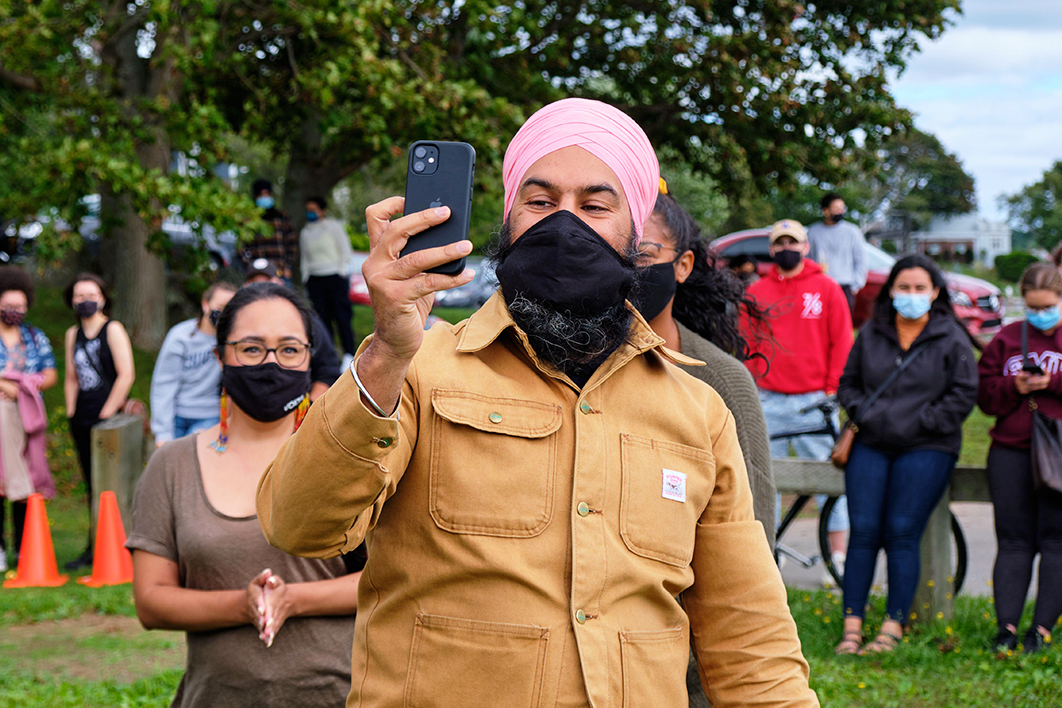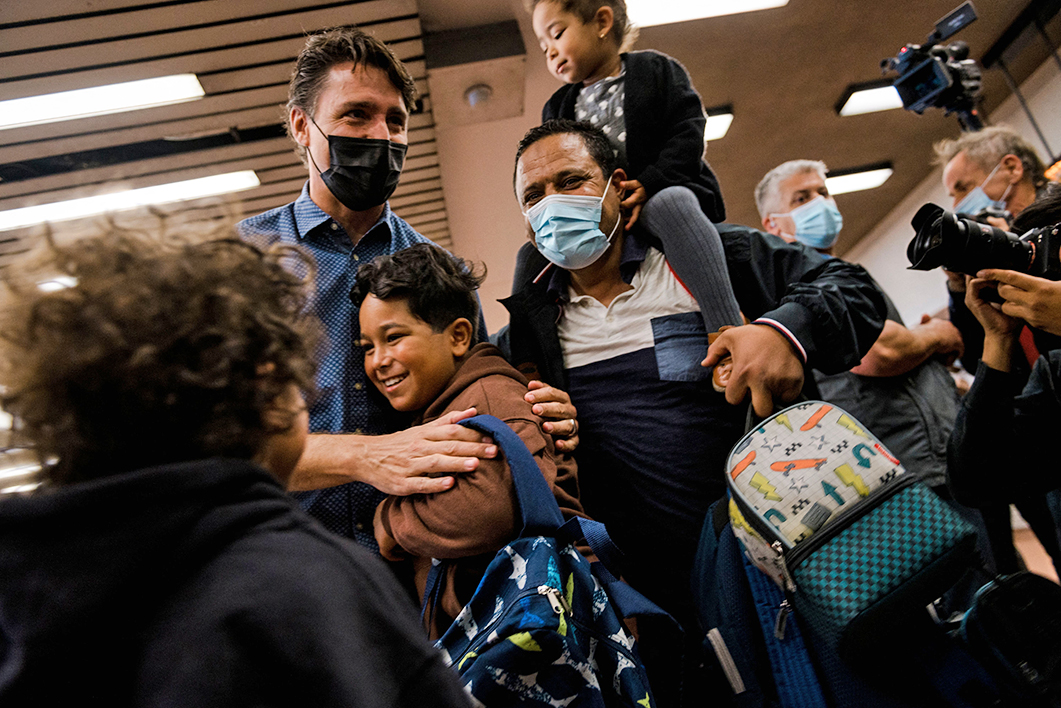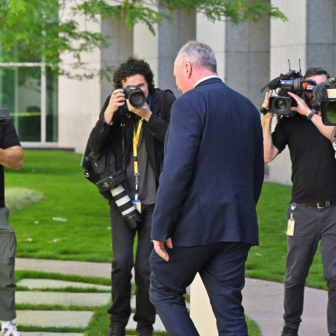When Canadians last voted, in the 2019 general election, the Liberals won 157 seats, the Conservatives 121, the Bloc Québécois thirty-two, the New Democrats twenty-four and the Greens three, with one independent making up the total. In Monday’s election, called early by prime minister Justin Trudeau, the Liberals won 158 seats, the Conservatives 119, the Bloc thirty-three, and the New Democrats twenty-five, with two Greens and one independent. See the pattern?
During the campaign the pundits had complained that this was a Seinfeld election — an election about nothing. After the results came in, the wits said that Canada had experienced a Groundhog Day election; everyone woke up to the same thing as the day before.
Minority parliaments are common in Canada. Four of the six elections prior to this one yielded a minority government, and ten of the last twenty back to 1957. Trudeau is the third prime minister to chafe at the inconveniences of minority rule, fold in his hand hoping for a better deal, and end up with much the same. In fact, the 2021 result is strikingly similar to 1965, when Liberal prime minister Lester Pearson ended up with a second minority, adding only three seats to his caucus. The other similar result was Trudeau’s predecessor Stephen Harper, who won minorities in 2006 and 2008, boosting his count by sixteen seats largely at the expense of the Liberals.
So Justin Trudeau is back where he was two months ago. After a glorious majority in 2015, he was humbled by his minority finish in 2019 but lacked the patience to stick with that result. From the very start of the 2021 race, he struggled to articulate a clear reason why it was happening, other than the obvious: rank opportunism. Parliament was working well by minority standards; the government had no bold new initiatives for which it sought a mandate; the country faced no obvious crossroads.
As much as anything, the election displayed Trudeau’s lesser qualities — overconfidence and impetuousness. The prime minister has a gracious and idealistic side but also a formidable capacity for political aggression, and the latter clearly drove the decision to trigger an election wanted by no one else in the country, or perhaps even in his party. His campaign tone was primarily negative, as he relentlessly attacked the Conservatives and their leader Erin O’Toole. He framed the election as “maybe the most important since 1945 and certainly in our lifetimes,” but unlike the postwar election that ushered in the Canadian welfare state, this campaign offered no dramatic choices and Trudeau struggled for evidence to make his case.
But an alternative interpretation of the result would focus on the continuing durability of Justin Trudeau. For much of the election, the momentum rested with the Conservatives, and Trudeau’s successful clawback was an achievement in itself. In retrospect, the election call was ill-advised but not fatal. It can arguably be added to the long list of Justin Trudeau comebacks, some from self-inflicted injuries, since he first assumed the leadership of a weak third-place party in 2013. And by forcing the election, Trudeau may have triggered a structural crisis in Canadian conservatism. He faced his most formidable opponent yet in Erin O’Toole, who has dragged his party into the political centre. Yet O’Toole failed to deliver a bigger haul of seats, and both his leadership and his strategy are now in question.
From 2004 to 2015 the Conservative Party of Canada was in the iron grip of Stephen Harper. Having led the party to three successively stronger election victories in 2006, 2008 and 2011, Harper enjoyed enormous support in the party — support he worked to maintain by sticking close to the core membership. He openly disdained intellectuals, journalists, and other elites that most party members didn’t much care for either. Despite living for nine years in the prime minister’s residence at 24 Sussex Drive — on which he refused to spend taxpayer money despite its accelerating decline — he never seemed comfortable in the Ottawa bubble, which in turn was never comfortable with him.
Most of all, Harper was stubborn. While known to be thoughtful and open-minded in private, he stuck to his guns publicly, hating to retreat or be seen as playing to public opinion. Remarkably introverted for a politician of his level, he struggled to smile when he didn’t feel like it.
After Harper’s 2015 defeat and resignation of the leadership, a consensus emerged among many Conservatives that the party had grown too “mean.” It was partly that impulse that drove it to adopt as its new leader Andrew Scheer, a thirty-eight-year-old father of five who seemed incapable of not smiling. But Scheer, who had failed to make cabinet under Harper (instead spending a term as speaker of the House), lacked Harper’s tougher instincts. Vulnerable also as a socially conservative Catholic with a record of opposing marriage equality and abortion rights, Scheer only managed to hold Justin Trudeau to a minority in 2019. Within a few weeks he was consumed by intra-party squabbles and resigned.
Erin O’Toole replaced Scheer in August last year, campaigning for the leadership as a “true blue” Conservative who would “take back Canada.” Then, on the night of the leadership victory, he switched his tone, proclaiming the party was open to all. Regardless of background or identity, he said, “You are an important part of Canada and you have a home in the Conservative Party of Canada.” It was quite a switch from the Harper years.
O’Toole steered the party in unexpected directions, reaching out to private sector unions and expressing scepticism of the free-trade orthodoxy that had long inhabited the party. He avoided the usual rants about taxes and government spending, and finally introduced a Conservative carbon tax proposal, which had been resisted for years. He also broke with the tone of stubbornness long entrenched in the party, often with small gestures.
One hot spring day, for instance, he tweeted a picture of himself with a beer after a run, with the caption “Rebecca had a cold one waiting for me.” This attracted some snide remarks on the implied traditional gender roles, and so O’Toole responded with a tweet showing him pouring a glass of wine for his wife. Stephen Harper — who would never have tweeted himself jogging in the first place — would have refused on principle to play along and respond to the snide criticisms. But O’Toole had no problem adapting as needed.
This was Justin Trudeau’s opponent — much sunnier and nimbler than his predecessors, and set on pushing the Conservatives to the political centre. But O’Toole still led Stephen Harper’s party. A party convention in January 2021 voted down a policy resolution affirming that climate change is real, and in June the party caucus split over government legislation to ban “conversion therapy” for LGBT persons. Nostalgia for the iron leader remained; a speculative July poll found that Harper outpolled O’Toole when matched up against Justin Trudeau.
While most Canadians have supported pandemic restrictions and vaccinations, about a fifth of the population is sceptical, and that fifth is concentrated on the political right. O’Toole himself seems to have no issues with vaccines, but many potential Conservative voters do. In the western provinces of Alberta and Saskatchewan, Conservative premiers lifted most Covid restrictions at the beginning of the Canadian summer in early July, with Alberta premier Jason Kenney proclaiming “the best summer ever” now that personal freedoms had been restored. (With clear evidence that a new wave loomed, most other provinces kept restrictions in place.) And the People’s Party of Canada, founded and led by former Harper minister Maxime Bernier, loudly occupied the extreme right as a haven for anti-vaxxers, xenophobes, and others unlikely to support O’Toole’s centrist agenda.
The instability on the right and O’Toole’s uncertain grip on his party probably played heavily into Trudeau’s electoral calculation. He also hoped to be credited with good pandemic management. In autumn 2020, the minority premiers of British Columbia and New Brunswick called early elections and were rewarded with majorities, a welcome precedent for Trudeau. The Saskatchewan government was also re-elected around that time, making the pandemic look good for incumbents. And Nova Scotia’s Liberal government seemed set for re-election on 17 August, two days after Trudeau made his trip to the governor-general to ask for dissolution and an election.
But the Liberals stumbled from the start. Trudeau announced the election on a Sunday morning with his line that it was the most important since 1945, but immediately struggled to explain why. The Conservatives attacked this “unnecessary election” and released their platform, while Trudeau fumbled to gain momentum and control of the agenda. And on Tuesday Nova Scotia’s Liberals were unexpectedly defeated, a poor augur for their federal cousins.
There were few key issues in the election — or, more precisely, issues the parties wanted to polarise over. Each repeatedly tried to set the agenda but couldn’t get the others to bite. Discussion focused mostly on the adequacy of each party’s response to agreed challenges — who had the best climate change plan, who could curb soaring housing prices, and so on. Promises flowed, but amid the deluge there were few sharp debates.
The Liberals’ strategy was in plain sight: to scare voters away from the Conservatives, much as they had done in 2019 with Andrew Scheer. They blasted away at the social conservative cracks in the party, such as O’Toole’s support for “conscience rights” for doctors to not refer patients for abortions. But O’Toole hit back, saying “I’m pro-choice and I’m a pro-choice leader, period.” Unlike his predecessors, his own record was clear of social conservative marks and he didn’t get bogged down defending his concessions to the social conservative wing of the party.

Staking out of the left: New Democrats leader Jagmeet Singh campaigning in Halifax early this month. meanderingemu/Alamy
Even more striking was his stance on guns. The Conservative platform pledged to relax restrictions on some classes of rifles, a move the Liberals attacked as legalising “assault-style weapons.” O’Toole deflected this by modifying the platform in the middle of the election, saying the restrictions would remain in place, pending a review after the party formed government. This was another small but powerful break from the Harper tradition of digging in. Over and over, O’Toole refused to take the bait, blunting the Liberal tactics.
The other Liberal strategy was to gain seats in Quebec, primarily against the Bloc Québécois. Over the past year Trudeau had been noticeably generous and conciliatory towards the nationalist provincial government in Quebec, led by François Legault, hoping to gain at least benign support. But the Quebec plan collapsed in two ways.
First was in the English-language leaders debate on 9 September (which always includes all major leaders including the Bloc, despite its only running candidates in Quebec). Moderator Shachi Kurl provocatively asked Bloc leader Yves-François Blanchet to defend Quebec’s “discriminatory” laws banning the wearing of religious symbols among public servants and further enforcing the use of French. Blanchet took issue with the factual declaration that the laws were discriminatory, an opinion widely held in English Canada but firmly rejected in Quebec. The question resonated for the rest of the election in Quebec, likely shoring up Bloc support against English-Canadian interference.
Then came the second blow, when Legault unexpectedly endorsed the Conservatives as the best choice among the national parties to respect Quebec’s interests. The Quebec roof collapsed on the Liberals; though they managed to hold their seats, their plans of growth were thwarted.
Those two strategies negated, the Liberals were at least able to hold off the New Democrats on their left. New Democrats leader Jagmeet Singh performed well in his second election, focusing on a tax-the-rich platform with a skilled use of social media. As Trudeau’s charisma fades, Singh has become the most interesting leader in Canada, combining tailored suits with the laid-back cadence of a Californian surfer. His focus on Trudeau’s broken promises allowed him to stake out strong ground as the true progressive in the race. But not much took off, and it is unclear whether the heavy social media focus on younger voters yielded much for the effort.
The one party with momentum was the People’s Party. Leader Bernier ranged across the country, unmasked and unrepentant, drawing large, enthusiastic and undistanced crowds, railing against vaccines and vowing to cut immigration levels in half. The party rose in the polls, surpassing a hapless Green Party consumed by infighting. The People’s Party posed a clear threat to the Conservatives, though it is unclear how much of its support drew directly from the Conservative base. Polling suggests it also attracted support from former Liberals, Greens and even New Democrats, as well as chronic non-voters. Still, it undoubtedly distracted O’Toole.
Polls showed a neck-and-neck race between the Liberals and Conservatives, well within the margin of error. And while O’Toole could deflect Trudeau’s attacks, he struggled to make his party grow. While the other major parties proudly proclaimed that all their candidates were vaccinated, O’Toole refused to release such information or declare whether he would enforce a vaccination requirement on his MPs. As well, halfway through the campaign, a pattern developed of aggressive and verbally abusive anti-vaccine protesters showing up at Trudeau’s outdoor events, and one People’s Party activist was charged with throwing gravel at Trudeau.
While the protests were disturbing, Liberal strategists were likely filled with at least some glee to see their noble leader facing off against anti-vaxxers, and Trudeau tried to link the protests to the Conservatives by claiming that “Erin O’Toole is at least taking some of his cues from them.” O’Toole condemned the violence, but the images played well into Liberal attempts to polarise the election.
Then, just four days before election day, Alberta Conservative premier Kenney made a sober announcement that the “best summer ever” had been a disaster, with Covid rates skyrocketing and restrictions reimposed. Any remaining Conservative momentum was stopped in its tracks.
While many scenarios were envisaged, election night ended up fulfilling long-time Ottawa pundit Paul Wells’s First Rule of Canadian Politics: “For any given situation, Canadian politics will tend toward the least exciting possible outcome.” While there was some reshuffling — after being shut out of Alberta in 2019 the Liberals won two seats in the province, likely due to Kenney’s mess — fewer than thirty of the 338 constituencies changed hands. Debate now rages about whether the election changed anything at all. Did it affirm the country is going in the right direction? Did it prompt the Liberals to offer policies they might not have otherwise pledged? Was it an “unnecessary” election? If so, what makes a “necessary” election?
The most vulnerable victim of the election is Erin O’Toole. While losing the seat count, the Conservatives surpassed the Liberals in the popular vote, approximately 33.8 per cent to 32.5 per cent (mail-in votes are still being counted). But ideological purists began to turn on O’Toole even before he made a ringing defence of his inclusive vision for the party in his concession speech. Andrew Scheer lasted only a few weeks after delivering a similar result; O’Toole’s fate remains to be seen.
Meanwhile, the People’s Party captured 5 per cent across the country, winning no seats (Bernier was trounced by the Conservative in his own home riding) but demonstrating its force as a movement on the political right. Debates about O’Toole’s leadership will thus cover not only his performance but also the entire direction of the party. Should it continue trying to impress and win over the political centre, or retreat to the Harper model and stop any leakage to the People’s Party?
Left standing is Justin Trudeau, three-time election winner but once again heading a minority government, with the lowest popular vote ever for a Canadian federal government. Although his grip on the leadership of the party remains strong, its trust has been tested by a rollercoaster experience with no obvious net gains. But Trudeau can claim a weak but tangible mandate for the direction in which he is taking the country, and has shown once again that one cannot quite count him out. •




